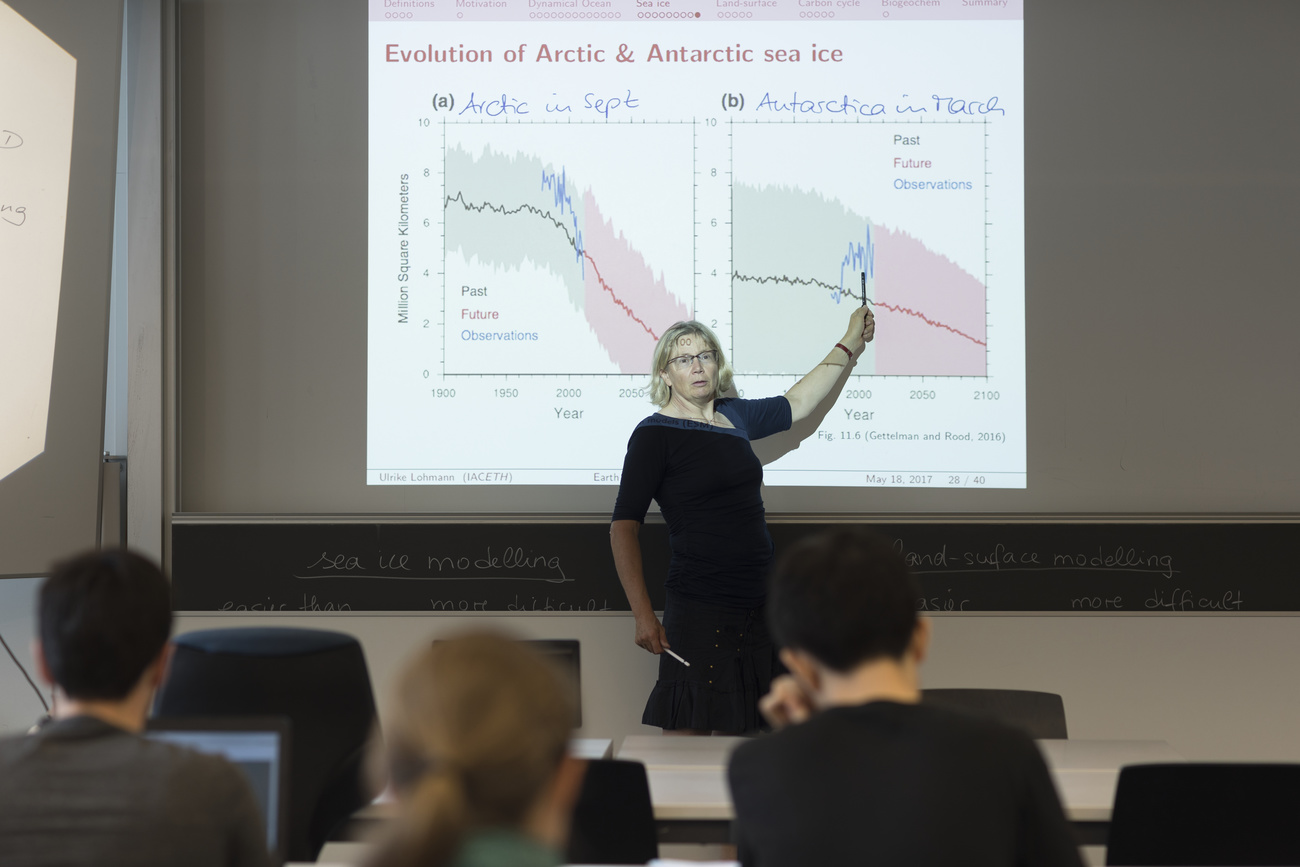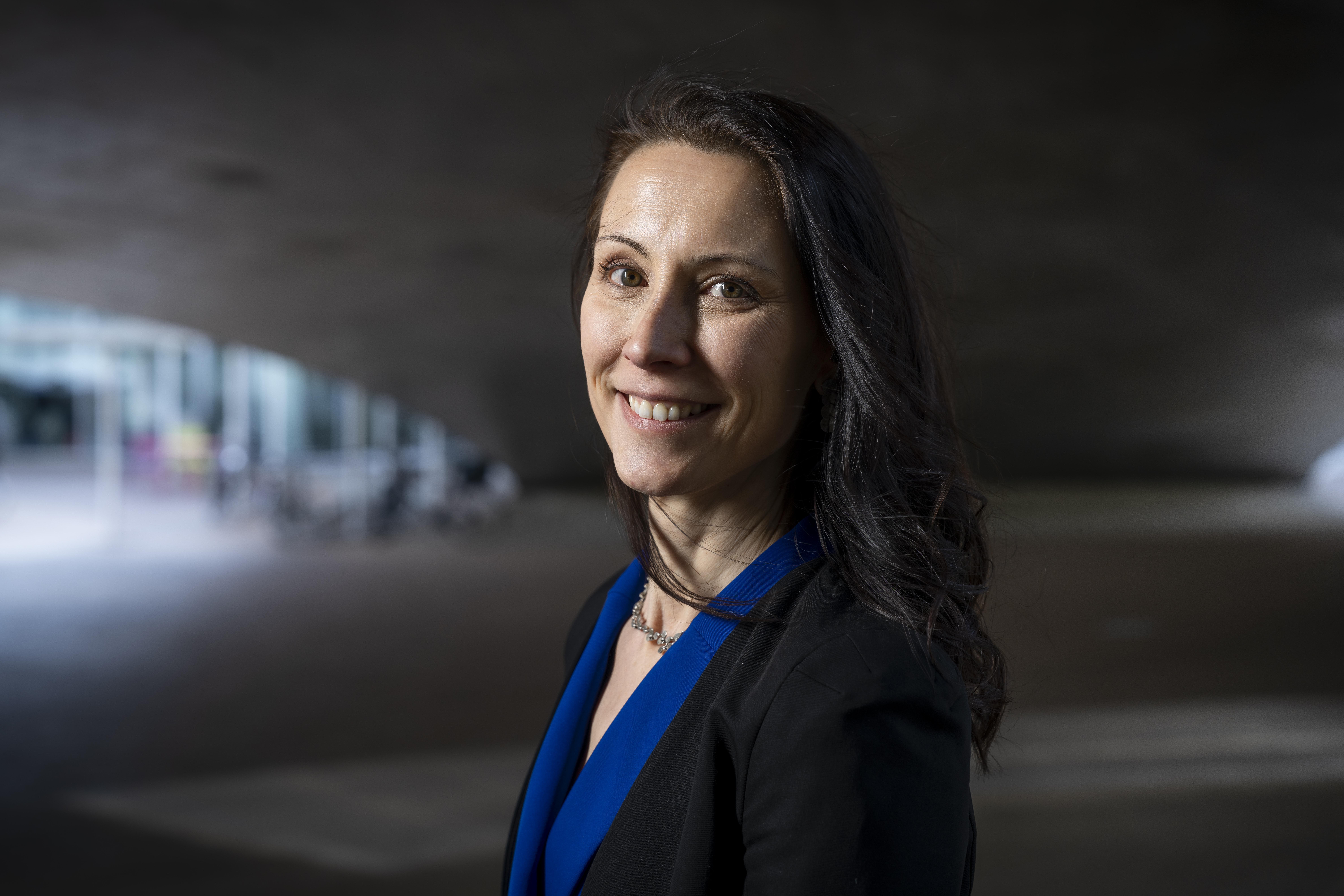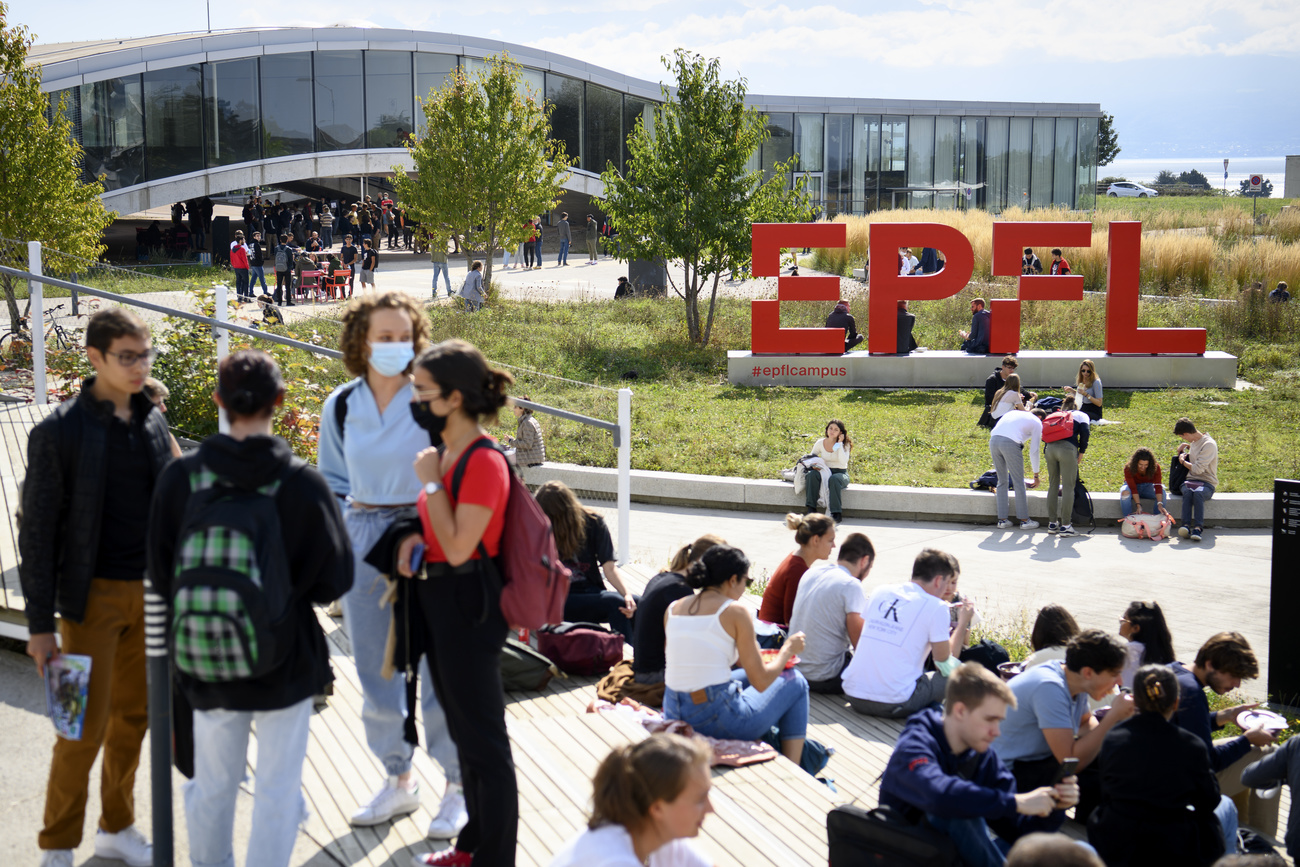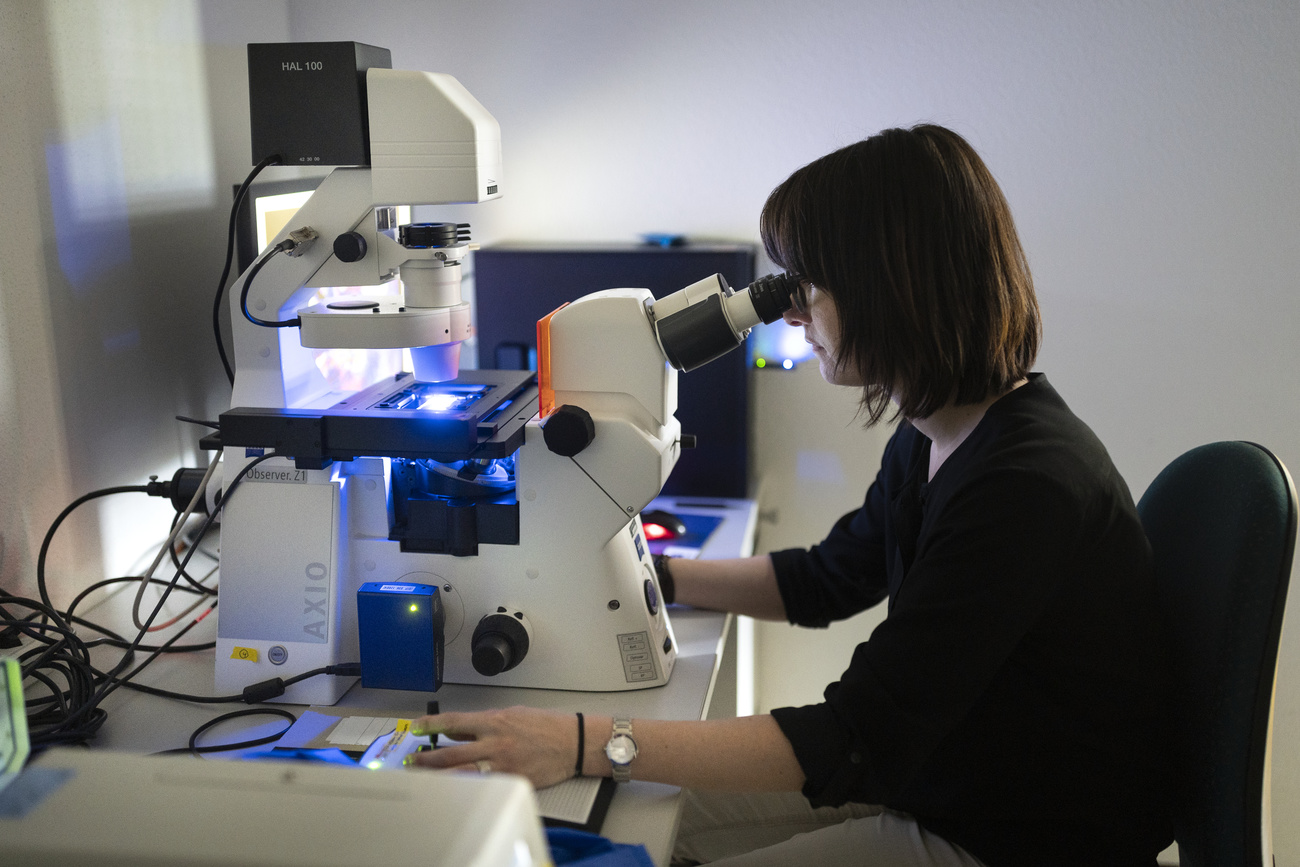Progress towards gender equality in Swiss academia remains slow

Switzerland’s prestigious Federal Institute of Technology Lausanne (EPFL) this week appointed the first female president in its 141-year history. Despite more women studying at Swiss universities than men, few make it to the upper echelons of the academic world. A tour of some key data.
Anna Fontcuberta i Morral, a 49-year-old professor of materials science and engineering, is on cloud nine.
“Merci, danke, grazie to [government minister] Guy Parmelin and the Federal Council for this nomination and their trust. I’m honoured and look forward to starting as EPFL president on January 1, 2025,” she tweeted on March 27.
It has been a long wait for the technology-oriented university to be led by a woman. But the Spanish-Swiss dual national is convinced things are moving in the right direction.
“Twenty years ago you could count the number of female professors on one hand,” she told Swiss public radio, RTS, on Thursday.
“In the materials science field around a third are women, but there are areas where there are many more, like engineering. There have been great efforts and now many more female professors.”
Despite her optimism, under-representation of women in academia persists in Switzerland. Women account for almost 45% of doctoral students and 53% of all university students in Switzerland. But like its European neighbours, the higher up the hierarchy you go, the fewer women there are in academia.
Only 24% of top professorships at Switzerland’s 12 universities are held by women. This is below the average for the 27 EU member countries (26%), according to the European Commission’s latest “She Figures report” from 2021.External link
The Federal Statistical Office (FSO) points out that over the past 11 years the proportion of women among the teaching staff of higher education institutions, made up of professors and other teachers, has been rising: from 24.3% in 2012 to 30.1% in 2022. The share of female professors alone has increased even more from 19.3% in 2013 to 28.4% in 2022. But progress has been slow.
In Europe, women are more likely to graduate in the arts and humanities, social sciences, journalism, and business administration and law. The lack of women is more severe in STEM (science, technology, engineering and maths) areas, particularly in information and communication technologies and engineering, manufacturing and construction. Women are, however, over-represented in the life sciences.
In Switzerland the highest proportion of female professors are in humanities and social sciences (37%) and the lowest in the technical sciences and economics (18%) and natural sciences (17%), according to swissuniversities.
Aside from teaching staff, the percentage of women employed as managers and top officials ranges from 29% at universities to 35% at universities of applied sciences and 39% at universities of teacher education.
“There has been some progress [in the EU] towards improving women’s representation in decision-making and leadership positions,” said the authors of the latest European Commission’s “She Figures” report. “But women represent less than 25% of heads of institutions in the higher education sector in 2019. In 2019, just over 3 in 10 board members were women (31.1%) and under one-quarter of board leaders (24.5%) were women at European level.”
In Switzerland 24.4% of heads of universities were women in 2019.
“Given the small number of positions concerned, this percentage can vary by several percentage points with the appointment of just one or two people. As a result, in recent years the proportion has remained relatively stable at between 24-30%,” explained Pierre Sollberger of the FSO.
‘Leaky pipeline’
The phenomenon in which women struggle to progress up the academic ladder, in part due to the difficulty of combining career and family, is universal and often referred to as the “leaky pipeline”. The number of women leaving academia is higher than the rate of attrition among men, despite more women graduating from university.
In surveysExternal link, women have linked their departure to issues in reconciling family and academic life, lack of female role models and networking plus gender bias in the hiring and promotion processes. Switzerland also suffers from specific structural issues: childcare provision is scarce and very expensive compared to other European countries and well-paid jobs in industry offer an attractive alternative for academics.

More
The women changing science in Switzerland
Not everyone agrees with the “leaky pipeline” metaphor. A reportExternal link commissioned last year by the Swiss National Science Foundation (SNSF) that reviewed gender equality measures in academia called the term “misleading”.
“It suggests that women mysteriously drop out of academia and therefore conceals structural barriers and the inherently gendered arrangement of the academic system, which disadvantages women in their career progression,” the authors concluded.
Numerous studies record a gender bias in research evaluation criteria and procedures that consequently affect recruitment, promotion and funding, said the report compiled by a research team from the University of Basel led by gender expert Andrea Zimmermann.
Women often find having a family incompatible with the demands of an academic career, the authors wrote.

More
Science in Switzerland: the women driving change
To increase the number of female professors and, above all, to retain women in academia, research institutions and foundations in Switzerland and the EU have introduced further measures, such as grants, mentoring and childcare support (see infobox below).
The SNSF has introduced quotasExternal link for women on its evaluation committees. This is to raise the visibility of women in research and take their perspectives better into account for research policy decisions.
Last year’s comprehensive reviewExternal link is being used by the SNSF to plan future measures aimed specifically at increasing the number of women in research, promoting an equal and inclusive working environment, and creating gender-inclusive knowledge.
Other measures to promote women in science
From 2022, the Gender Equality Plan (GEP)External link has become mandatory for universities and research institutions in EU member states and associated countries participating in Horizon Europe, the EU’s key programme for research and innovation. Switzerland lost its Horizon Europe status when negotiations with the EU over a broad political treaty broke down in May 2021. It is hoping to rejoin this year.
Some 95% of higher education institutions in Switzerland detail gender equality strategies on their websites. Measures include gender monitoring, counselling, workshops on soft skills, mentoring, networking, and workshops on gender bias.
A series of funding grants aimed at women are available in Switzerland, mainly from the Swiss National Science Foundation (SNSF)External link. The Flexibility grant helps doctoral students and post-doctorates with children to cover external childcare costs or salary costs for supporting staff. The Gender Equality grant offers young researchers CHF1,000 ($1,110) per project year that can be used for mentoring, coaching, courses, conferences, and workshops.
The SPIRIT funding programme, launched in 2019, promotes collaborative, international research with a focus on promoting female scientists and gender-specific research questions. Funding ranges from CHF50,000 to CHF500,000 over a two- to four-year period. The PRIMA grant, launched in 2017, supports women with a high potential for a professorship. Successful grantees receive up to CHF1.5 million in funding to cover their salary and project costs for five years within a Swiss research institution.
Finally, there’s the H.I.T. ProgramExternal link (High Potential University Leaders Identity & Skills Training), a collaboration of ten cantonal universities and the two federal institutes of technology. Female professors receive a training package, individual coaching, professional networking, peer mentoring and leadership shadowing to prepare them for leading positions in academia and to help them develop gender equality and diversity competences.
Edited by Virginie Mangin/ts

In compliance with the JTI standards
More: SWI swissinfo.ch certified by the Journalism Trust Initiative




You can find an overview of ongoing debates with our journalists here. Please join us!
If you want to start a conversation about a topic raised in this article or want to report factual errors, email us at english@swissinfo.ch.